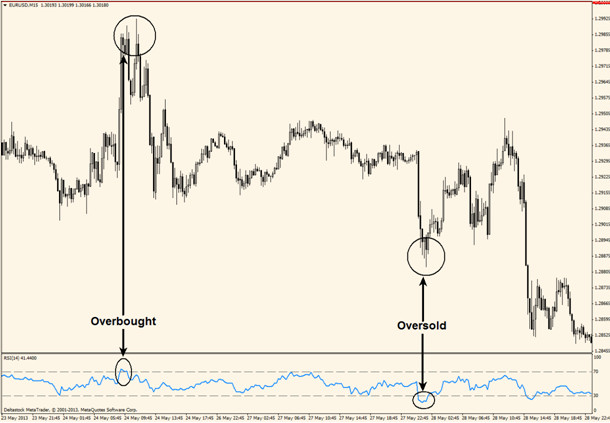Relative Strength Index – Old School is Good School!
Full Review of the Relative Strength Index Tool for Binary Options
I’ve been browsing lately thatsucks.com, wondering what tool I should review next. What’s missing but could be of use to Binary Options traders? I have some good and useful custom indicators… there’s never a shortage of that because the Internet is full of free tools, but it hit me: one of my all time favorite indicator is not reviewed. The Relative Strength Index, aka RSI. Good, there’s no time to lose, let’s get to work.
What is the Relative Strength Index and how to use it?
The RSI is a momentum oscillator caped between 0 and 100 and developed by J. Welles Wilder. It was first introduced to the public in 1978 in the book New Concepts in Technical Trading Systems. It is true that the concepts considered new in 1978 are not so new anymore, but the RSI still remains one of the top indicators even today.
The Relative Strength Index measures the magnitude and velocity of price movements; in other words, it will move up if price moves up and the distance it travels is directly related to the strength of the price move. The usual setting for this indicator is 14 but some traders use 21 (if you use 21, the RSI movement will be slower and you will get less signals but more reliable).
One of the main strengths of the RSI is its ability to signal Overbought and Oversold territory and this is accomplished with the use of two levels: 70 and 30. Almost all charting packages that offer RSI will plot these levels by default so once you attach the actual indicator to a chart, the levels will probably be there. You might wonder what Overbought and Oversold means and the best way to explain is to put aside all technical talk and use simple words: if an asset is Overbought it means it has gone up too much and it must come down. Oversold means it has gone too low and it must go up now. And here’s the picture to clear any ounce of confusion:

As you notice, once the Relative Strength Index goes into Overbought territory (that is above 70), price starts to drop and once it goes into Oversold territory (below 30), price starts to climb. In other words, the Relative Strength Index signals a reversal and it manages more often than not to identify tops and bottoms. In strong trends, the RSI will remain Overbought or Oversold for a longer period so don’t be trigger happy with your Calls and Puts. Have patience and understand this is just a tool which is not meant to be used by itself.
With the Overbought/Oversold problem out of the way, now I will tell you another “secret” of the RSI: it is one of the best indicators used to identify Divergence. Yes, I know what you might be thinking: “I didn’t manage yet to wrap my head around the whole Overbought/Oversold thingy and you tell me about this Divergence”. And you know what, you might be right so let’s forget all about Divergence; it’s too hard to understand anyway and it requires a lot of work to master… But just in case some of you really want to get better at trading and are ready to put in the work, here is the link to my article explaining Divergence for binary options, another one of my favorite tools.
Why does the Relative Strength Index Suck?
It doesn’t and that’s that! Unless you believe it is the Holy Grail, this is one of the best indicators out there. Keep in mind that during a strong trend it is more likely to get a false signal from it, but just like I said, don’t be trigger happy with your trades and don’t use the RSI on its own.
Why doesn’t the Relative Strength Index Suck?
Its ability to predict reversals is well known and the fact that it has been around for a long time shows us that traders still use it with success. It can show the strength of a move, the potential end of a move and a consequent reversal, you can identify Divergence with its help and the 50 level is often regarded as a confirmation of a trend (RSI above 50 = uptrend; RSI below 50 = downtrend). I think these are good enough reasons to confidently say “It Doesn’t Suck”.
Wrapping it up
The strength of the RSI is… relative, which means that it is as good as the trader who uses it. The indicator itself is very reliable but it can lead to bad trading decisions, just like any other indicator, especially if it is misinterpreted or if the trader fails to see the bigger picture and relies solely on it. The trader has to learn to use it correctly and to recognize the best signals. Think of it similar to a car: even the best car sucks if the driver doesn’t know what he’s doing.
Discuss this Strategy on our Forums – Relative Strength Index Forum Discussion